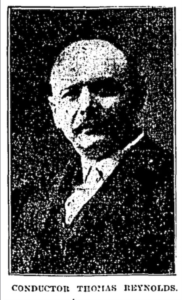b. 13/08/1861 Drumcole, County Cavan, Ireland. d. 06/03/1928 North Bay, Ontario.
DATE OF AM ACTION: 21/01/1910 near Webbwood, Ontario.
Thomas was one of twelve children born to James and Margary Reynolds (nee Dunn). In 1875, Thomas emigrated to Canada, and on 7th October 1891 he married Helen Maude Bradbier and they settled in North Bay, Ontario, where they had four children. His Albert Medal was presented to him by the Governor-General of Canada at Montreal, Quebec on 16th March 1910.
AM CITATION:
The ill-fated express train left Sudbury, Ontario, for Minneapolis, at noon on the day in question in charge of Conductor Thomas Reynolds. It consisted of the engine, a mail and baggage car, an express-package car, a second class coach, a colonist car, a first class coach, a dining car, and a Pullman sleeping car and, as it approached the bridge crossing the Spanish River at a point where the stream is 250 feet wide and 30 feet deep, Conductor Reynolds and several passengers were seated at dinner in the dining car. On reaching the bridge a part of the train left the track and plunged down the embankment. Two of the vehicles, a first class car and the dining car, crashed through the ice, which is said to have been 18 inches thick, and sank to the river bed. The first class car falling into some 15 feet of water, it is not likely that any of the occupants escaped. The dining car was almost completely submerged, and but for the resourcefulness and heroic conduct of the conductor the disaster would have resulted in a much heavier death roll. The fore part of bhe car rapidly filled with water and the occupants, hurled to the end of the car, were in danger of drowning in 10 feet of water, their situation being made more perilous by the accumulation of debris. Reynolds, on coming to the surface, found daylight entering from the top of a window some 6 inches above the level of the water, and, grasping a hat rack, he smashed with his feet the heavy plate glass windows. He then turned his attention to the imprisoned passengers, rescuing those in danger of drowning, and urging all to make use of the only means of support, namely, hat racks, lamps, &c. The passengers having been assisted in this way, he turned to effect an exit,’ only to find that the car had settled down, and that the opening made was submerged. After swimming about and locating the broken window with his feet, he dived and cautiously pushed himself through the window, using his feet to keep a hold on the window frame, in order that his body might not be swept away by the strong current. With great difficulty he brought his body between the broken ice and the submerged car and succeeded in gaining a foothold on the top of the car. He at once commenced wrenchingthe fan lights from the roof and succeeded in rescuing a lad and still another passenger through the small opening thus made. When shortly after, an axe was brought to him, in response to his cries for help, he enlarged the opening sufficiently to allow of the rescue of the other imprisoned passengers. Reynolds was badly cut and injured and was for some time under medical care.
BURIAL LOCATION: SAINT JOHN’S ANGLICAN CEMETERY, NORTH BAY, ONTARIO, CANADA.
LOCATION OF MEDAL: UNKNOWN.



